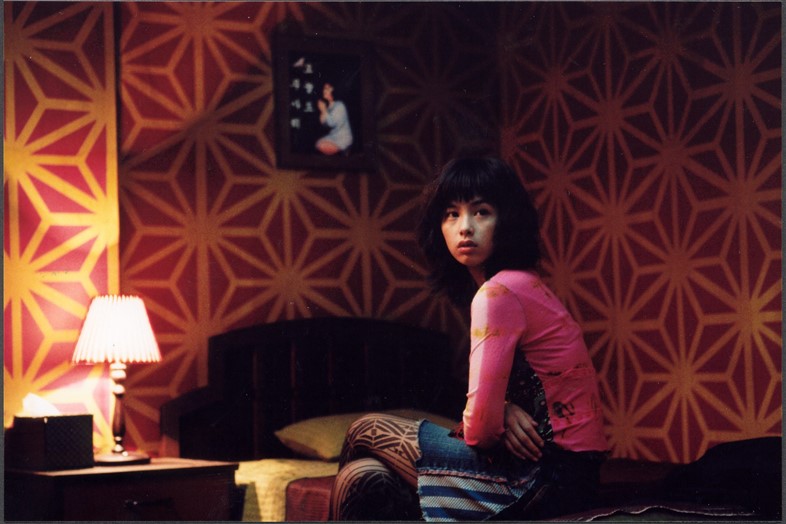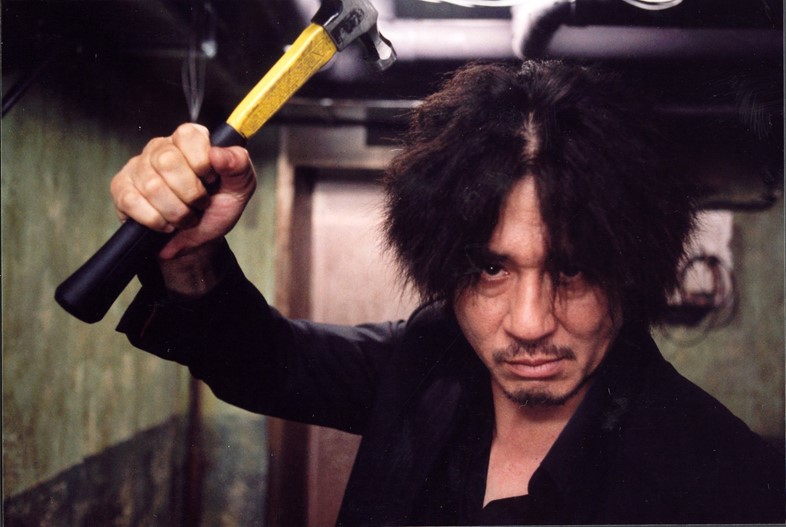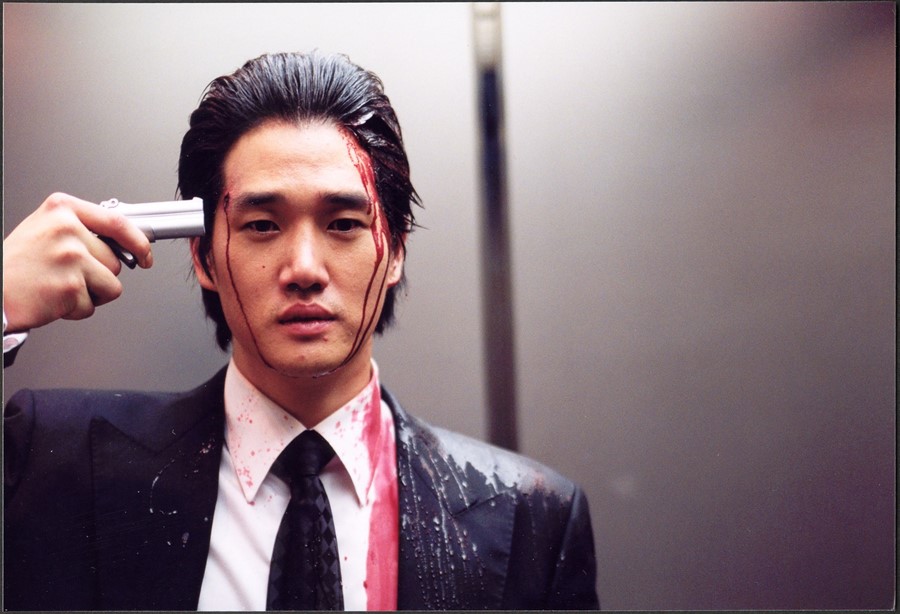Ahead of the South Korean thriller’s UK rerelease we talk to the film’s costume designer Jo Sang-gyeong about mixing style and sadism
It’s hard to choose the most memorable scene in Park Chan-wook’s South Korean neo-noir thriller Oldboy, which is about to receive a re-release in the UK at the beginning of August. It might be the scene when Oh Dae-su, our protagonist, first visits a sushi restaurant after his long incarceration. He wants to connect with another organism, so he orders “something alive – anything” and we slowly watch him stuff a live octopus into his mouth and digest it, before passing out on his plate, the octopus eerily crawling back out of him to escape into the real world... just like he has.
If not that scene, it’s surely the famous kung fu fight scene, shot diorama-like in one long take, where Oh Dae-su takes on fifteen men with nothing but a claw hammer, or the squirm-inducing part where he slowly wrenches out his enemy’s teeth one by one, or that scene towards the end of the film, which – if you can bear to look – features a nauseating act of self-mutilation, the perfect crescendo to a film that is wildly unpredictable throughout.
For those who haven’t seen Oldboy, you’ll be getting the idea by now: it's a lot to stomach. But as with Tarantino, the violence is softened by knowing humour and heightened stylisation, as though Chan-wook – a fan of exploitation films – is revelling in the medium of cinema itself.
It makes perfect sense that the action in Oldboy verges on cartoonish when you consider that the storyline is taken from a Japanese Manga of the same name. It was written by Garon Tsuchiya and illustrated by Nobuaki Minegishi, set in an area of Tokyo called Shinjuku Golden Town, and published in the Futabasha magazine Weekly Manga Action, between 1996 and 1998. (Later, it was adapted for America by Dark Horse Comics.) The plot of the manga and the film both centre around the story of a regular guy who is mysteriously kidnapped and put in a private prison, before being freed and set on a revenge mission to find and kill his captors.
In the comic, it’s ten years he’s trapped for, while in Chan-wook’s film, which dials up the sadism all round, it’s 15. Similarly, in the comic, protagonist Goto leaves his fiance at the altar, but in the film, Oh Dae-su’s wife is murdered and he is framed for the crime.
For much of the first half of Oldboy the movie, we watch Oh Dae-Su’s years in prison unfold. He goes through cycles of desperation; first, he begs for freedom, then he tries to kill himself, then he tries to work out who locked him up by writing down the name of everyone he ever wronged. He even tries to claw his way out of his cell through the wall by scraping away at the bricks with a sharpened chopstick. He trains his body to fight, in case he is ever released, and when this eventually happens, he emerges strong and superhero-like. But best of all is his superhero look: shaggy black hair, a black open-shirted suit and, weirdly, gold sunglasses.

“According to the script, the outfit Oh Dae-Su wears is provided by his captor Lee Woo-jin after fifteen years of his prison term,” explains Jo Sang-gyeong, the film’s costume designer, who has worked with Park Chan-Wook on six films. “So I thought Oh Dae-su’s suit should be harmonised with the whole atmosphere of Lee Woo-jin’s luxurious penthouse. I felt it would be good to show a specific brand’s garment label to emphasise its fine quality. S.T.Dupont, the French luxury manufacturer of men’s suits, lighters and leather goods, was one of the brands we reached out to, but they wouldn’t provide it, so we just sewed an S.T. Dupont label into the suit jacket, which was custom-made for him by a local Korean tailor shop.”
However, S.T. Dupont did provide all the clothes filled in Lee Woo-jin’s incredible closet, she adds. And Oh Dae-su’s gold sunglasses were inspired by an old woman she saw in an elevator.
Once on the outside, Oh Dae-su quickly meets Mi-do, a chef (the one who serves him the octopus), and they become both lovers and partners in solving the mystery of who incarcerated him. As for the incredible prints she wears, Sang-gyeong remembers: “Custo Barcelona had just been introduced in Seoul back then and I applied the brand’s strong prints and patterns for Mi-do. The brand provided some printed fabric for me and I designed and made a costume for Mi-do myself. You can see that outfit when Mi-do stares at the giant ant on the subway” – one of the many moments when the film slips into comedy surrealism.
“The script of Oldboy was about incest and everyone involved in the project was prohibited to leak the story – in fact, incest was an extremely controversial subject at that time in South Korea” – Jo Sang-gyeong
According to Sang-gyeong, it was difficult to get investment for the film, as there was a lot of scepticism. “Park Chan-wook’s previous work, Sympathy for Mr.Vengeance (2002), was a box office failure,” she explains. “The script of Oldboy was about incest and everyone involved in the project was prohibited to leak the story – in fact, incest was an extremely controversial subject at that time in South Korea.” However, it didn’t feel like too a challenging subject to her personally, she says. “If you’re comparing it to Oedipus or Chinatown, the incest description in Oldboy is no more traumatic.”
Oldboy was part of a trilogy of unconnected revenge films that included Sympathy for Mr. Vengeance and Chan-wook's film Lady Vengeance (2005), which Sang-gyeong also worked on. Later, she dressed his 2006 comedy I’m A Cyborg, But That’s OK, about a girl who checks into a mental health facility because she thinks she is a cyborg, and his 2016 film, The Handmaiden, a dark and erotic lesbian psychological thriller which transposes Sarah Waters’ book The Fingersmith from Victorian London to 1930s colonial-era Korea and Japan.
“His movie scenarios always inspire me the most, and I think his works are so witty,” says Sang-gyeong, adding that Chan-wook is more collaborative than most directors. “He accepts wholeheartedly any ideas and suggestions. I only had two full-length films in my filmography before I participated in Oldboy. Although I didn’t have much film experience, I had considerable experience and understanding in stage costume and it made my approach for Oldboy more intense and bold. And he accepted it. Every time I asked about the script, he kindly explained what he intended for me, but he never asked about costumes and specific styles. I guess he didn't want me to simply do what he intended – he regards costume in a movie to be entirely up to costume designers.”

While The Handmaiden was Chan-wook’s biggest international success, Oldboy was undoubtedly the filmmaker’s crossover film: it won him the Grand Prix at Cannes in 2004 and put him on the map as a cinema geek’s favourite director. Maybe this acclaim is why, in 2016, Spike Lee was chosen to direct an American remake of Oldboy, aiming to revamp the film for Western audiences in the English language. It’s hard to imagine why Lee, a master of style in his own right, would agree to ape another auteur’s aesthetic and plot. Starring Josh Brolin and Elizabeth Olsen, the US version of Oldboy lacks the style of the original, and most importantly, its gore and deranged sense of humour.
“He didn’t want me to simply do what he intended – he regards costume in a movie to be entirely up to costume designers” – Jo Sang-gyeong
All in all, the American Oldboy feels like an empty shell of the original. But Lee practically set himself up for failure; you cannot rival the original Oldboy as a perfect piece of cult cinema. It has an unforgettable score, an amazing 70s-inflected set design that perfectly compliments Mi-do’s outfits and of course, a script packed full of weird but beautiful proverbs and sadomasochistic mind games. The perfect example comes from one of Lee Woo-jin’s taunting phone calls to Oh Dae-su: “Laugh and the world laughs with you, weep and you weep alone,” he says. Like the rest of the film, it delicately treads the line between exaggeration and minimalism, the intriguing and the ominous.
“There was a huge typhoon in South Korea in the middle of the film shoot,” Sang-gyeong remembers, finally. “The shooting schedule was postponed and we watched what we had filmed by that point, which was an incomplete version of Oldboy. But I knew then that it would be a super intense and dramatic movie. Films in the early 2000s in South Korea were not as intense and controversial as Oldboy. They still aren’t.”
Oldboy is in select cinemas August 2, and on 4K digital download August 26, courtesy of Arrow Video. It's out on BluRay on 7th October.


